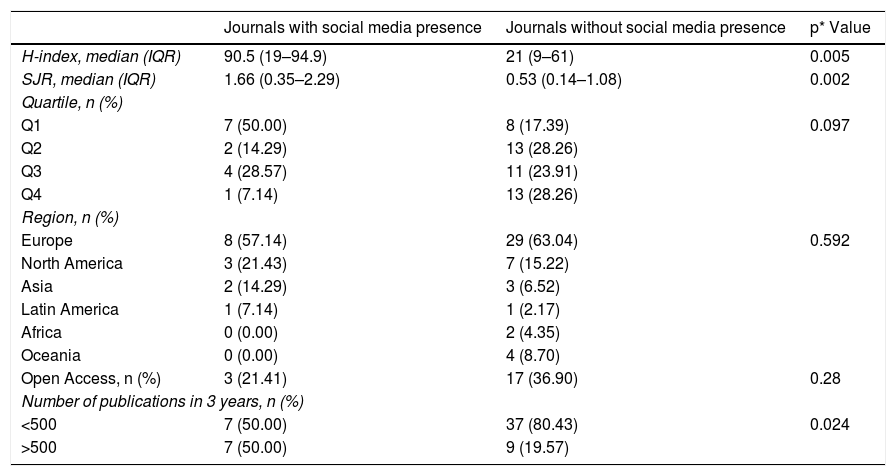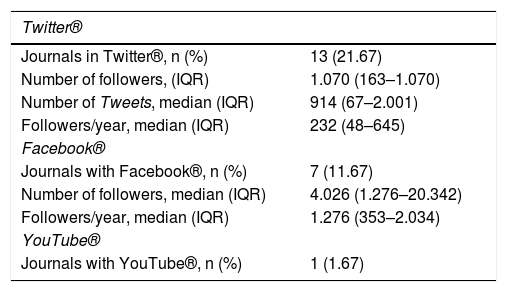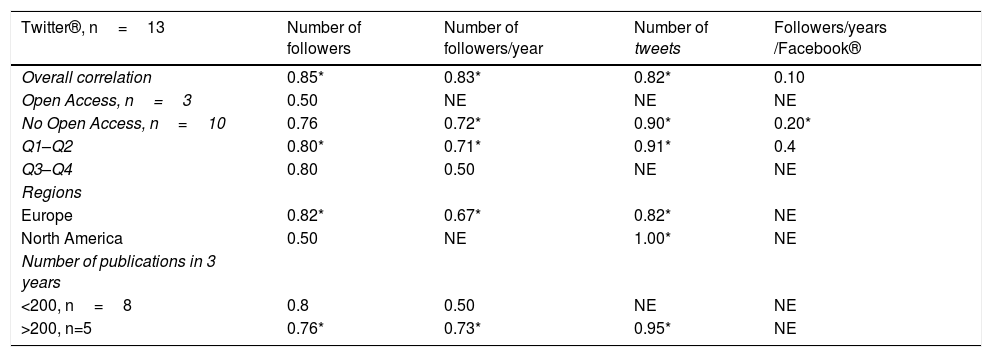The social networks like Twitter®, Facebook® and YouTube® have become interaction media with visualisation scientific information. Alternative metrics (altmetrics) have emerged that assess the dissemination and the impact of the scientific journals in the social networks. However, it is unknown if there is a correlation between the journal and the traditional measurements of impact based on the number of citations for the journal of rheumatology.
MethodsThe journals of rheumatology included in Scimago Country and Journal Ranking were identified, and the results of their metrics were collected based on the number of citations. The presence in social networks was determined using metrics, such as the number of followers and tweets. The correlation between them was evaluated using the Spearman correlation coefficient, adjusted for the time elapsed since the account was created.
ResultsOut of a total of 60 rheumatology journals, 14 had a presence in social networks. The Scimago journal ranking indicator (SJR) was higher in journals with a social network (90.5 vs. 21; p<0.05). The correlation between the SJR and Twitter® activity metrics was excellent: with the number of followers (r=0.85), followers/year (r=0.83), and number of tweets (r=0.82).
ConclusionThis study suggests that traditional impact metrics based on the number of citations correlate very well with the social network presence metrics of rheumatology journals, especially on Twitter®.
Las redes sociales como Twitter®, Facebook® y YouTube® se han convertido en medios de interacción y visualización de información científica. Han surgido medidas alternativas (almetrics) que evalúan la diseminación y el impacto de las revistas científicas en las redes sociales; sin embargo, se desconoce si existe correlación entre la actividad de las revistas de reumatología en redes sociales y las métricas tradicionales de impacto basadas en número de citaciones.
MétodosSe identificaron las revistas de reumatología a partir de la base de datos de SCImago de Scopus® y se extrajo la información de las métricas tradicionales basadas en el número de citaciones. Se determinaron métricas alternativas de actividad de las revistas en Facebook®, Twitter®, YouTube® e Instagram®. Se evaluó la correlación entre ellas usando el coeficiente de correlación de Spearman, ajustado por el tiempo transcurrido desde la creación de la cuenta.
ResultadosDe un total de 60 revistas de reumatología, 14 contaban con la presencia en las redes sociales evaluadas. El SCImago Journal Rank (SJR) fue más alto en revistas con red social (90,5 vs. 21; p<0,05). La correlación entre el SJR y las métricas de actividad del Twitter® fue excelente: con el número de seguidores (r=0,85), seguidores/año (r=0,83) y número de tweets (r=0,82).
ConclusiónNuestro estudio sugiere que las métricas tradicionales de impacto basadas en el número de citaciones, se correlacionan muy bien con las métricas de presencia en redes sociales de las revistas de reumatología, en especial en Twitter®.
Social media are the most visited websites in the world. Facebook® is the most popular social platform and the second site with more visits, while Twitter® ranks ninth.1 In the last few years, social media have become important platforms to disseminate scientific information, including health. This has increased the visibility and accessibility of content in journals and has opened up spaces for discussion and interaction among readers.2
Traditionally, the academic impact of both journals and articles has been measured using citation-based metrics, such the impact factor, the SCImago Journal Rank (SJR) or the H index. However, these metrics have been criticized, among other reasons because of the long time elapsed before citations are generated and hence to create greater impact.3 The advent and massive use of social media, has given rise to a new tool to assess the visibility and impact of scientific publications. These are the alternative metrics (almetrics), which measure the impact of both articles and journals in social media based on the number of followers (for instance, social media such as Twitter®, Facebook® or YouTube®), the number of publications, videos and tweets.4
The authors of research articles usually decide to which journal they will submit their manuscripts, after assessing the journals’ ranking based on citation metrics. The metrics about social media presence could also be taken into account with that purpose, since social media may expand the visibility and dissemination of the papers published and, in the end, strengthen their impact as a result of more citations of these articles.5,6
The purpose of this article is to assess whether there is any correlation between SJR, a traditional measurement based on the number of citations, and the presence and activity of rheumatology journals in social media, measured through indicators such as number of followers (Twitter®, Facebook® and YouTube®), the number of publications, videos and tweets of rheumatology journals in social media.
MethodologyUsing the database for scientific journals SJR powered by Scopus®, a search was conducted using the term «Medicine», and subsequently selecting the subset «Rheumatology», selecting all the journals found. Based on that list, a search was conducted of these journals in the social media Facebook®, Twitter® and YouTube®. The data was collected in the second week of March 2019.
Using SCImago, the following variables were chosen: SJR index, which uses in its calculations the citations from the Scopus® database, of the articles published in a journal over the last 3 years7; index H, which correlates the number of documents published in the journals with the number of times they were cited in the previous year8; quartile (Q1 to Q4), measure or position a journal versus to all the journals in the same area, according to the SJR9 index; number of documents published in the journals over the past 3 years; availability of the publications through open access and the region of the world where the journal is registered. Subsequently, the metrics in the social media Facebook®, Twitter® and YouTube® were collected, based on the official accounts of the journal: date in which the account was created in Facebook® and Twitter®; number of followers; number of tweets; number of subscribers, videos and YouTube® displays.
The statistical analysis was conducted with the Stata 14 College Station, TX: StataCorp LP software. The Shapiro–Wilk test administered showed a normal distribution, so the decision was made to use non-parametric statistics for the analysis. The comparison among journals with or without social media presence was made using the Mann–Whitney U test. To establish the correlation between SJR and the measures of presence and activity in social media, the Spearman coefficient was used, determining the statistical significance with a p value <0.05. The study was assessed by the Ethics and Research Committee of the university and hospital where the project researchers work.
ResultsA total of 60 rheumatology journals were identified in SCImago, 14 (23.3%) of which had official social media accounts, 7 had an active account in one, 6 in 2, and one of them had accounts in all of the three platforms (Table 1).
Characterization of journals with social media presence.
| Journal | Twitter® | Facebook® | YouTube® |
|---|---|---|---|
| Annals of the Rheumatic Diseases | Yes | Yes | Yes |
| Nature Reviews Rheumatology | Yes | Yes | No |
| Arthritis and Rheumatology | Yes | Yes | No |
| Osteoarthritis and Cartilage | Yes | No | No |
| Rheumatology | Yes | No | No |
| Current Opinion in Rheumatology | Yes | No | No |
| Journal of Rheumatology | Yes | Yes | No |
| Clinical and Experimental Rheumatology | Yes | No | No |
| Journal of Clinical Rheumatology | Yes | Yes | No |
| Current Rheumatology Reviews | Yes | No | No |
| Acta Reumatologica Portuguesa | Yes | Si | No |
| Revista Brasileira de Reumatologia | Yes | No | No |
| International Journal of Clinical Rheumatology | No | Yes | No |
| Indian Journal of Rheumatology | Yes | No | No |
The differences between the journals with and without social media presence are shown in Table 2. The H index (median 90.5 vs. 21; p<0.05) and the SJR (1.66 vs. 0.53; p<0.01) were higher for the journals with social media presence. The quartile distribution of the journals showed that 50% of the journals with social media presence were located in Q1, vs. 17% of the journals with no social media presence, although no significant statistical difference was established for this comparison.
Characteristics of Rheumatology Journals in terms of social media presence.
| Journals with social media presence | Journals without social media presence | p* Value | |
|---|---|---|---|
| H-index, median (IQR) | 90.5 (19–94.9) | 21 (9–61) | 0.005 |
| SJR, median (IQR) | 1.66 (0.35–2.29) | 0.53 (0.14–1.08) | 0.002 |
| Quartile, n (%) | |||
| Q1 | 7 (50.00) | 8 (17.39) | 0.097 |
| Q2 | 2 (14.29) | 13 (28.26) | |
| Q3 | 4 (28.57) | 11 (23.91) | |
| Q4 | 1 (7.14) | 13 (28.26) | |
| Region, n (%) | |||
| Europe | 8 (57.14) | 29 (63.04) | 0.592 |
| North America | 3 (21.43) | 7 (15.22) | |
| Asia | 2 (14.29) | 3 (6.52) | |
| Latin America | 1 (7.14) | 1 (2.17) | |
| Africa | 0 (0.00) | 2 (4.35) | |
| Oceania | 0 (0.00) | 4 (8.70) | |
| Open Access, n (%) | 3 (21.41) | 17 (36.90) | 0.28 |
| Number of publications in 3 years, n (%) | |||
| <500 | 7 (50.00) | 37 (80.43) | 0.024 |
| >500 | 7 (50.00) | 9 (19.57) | |
IQR: Interquartile range; SJR: SCImago Journal Rank.
Most of the journals with social media presence are in the European (57%) and North American (21%) regions. The most frequently used platform was Twitter® (21.7%), with a mean number of followers of 1,070, 914 tweets and a mean number of followers/year of 232. The second most popular platform was Facebook® (11.6%), with a mean number of followers of 4,026 and 1,276 followers per year. Only one journal had YouTube® presence (Annals of the Rheumatic Diseases), with 84 subscribers, 74 videos and 11,324 displays. The social media activity is shown in Table 3.
Description of social media activity.
| Twitter® | |
|---|---|
| Journals in Twitter®, n (%) | 13 (21.67) |
| Number of followers, (IQR) | 1.070 (163–1.070) |
| Number of Tweets, median (IQR) | 914 (67–2.001) |
| Followers/year, median (IQR) | 232 (48–645) |
| Facebook® | |
| Journals with Facebook®, n (%) | 7 (11.67) |
| Number of followers, median (IQR) | 4.026 (1.276–20.342) |
| Followers/year, median (IQR) | 1.276 (353–2.034) |
| YouTube® | |
| Journals with YouTube®, n (%) | 1 (1.67) |
IQR: Interquartile range.
The overall correlation using Spearman’s coefficient of correlation between the number of followers, followers/year and publications in Twitter® with the SJR index was excellent (r=0.85, 0.83 and 0.82, respectively; p<0.05). The correlation was better between the Q1 and Q2 journals, and among those with over 200 publications in the last 3 years (Table 4).
Correlation between SJR and different alternative metrics for presence in Twitter® and Facebook®.
| Twitter®, n=13 | Number of followers | Number of followers/year | Number of tweets | Followers/years /Facebook® |
|---|---|---|---|---|
| Overall correlation | 0.85* | 0.83* | 0.82* | 0.10 |
| Open Access, n=3 | 0.50 | NE | NE | NE |
| No Open Access, n=10 | 0.76 | 0.72* | 0.90* | 0.20* |
| Q1–Q2 | 0.80* | 0.71* | 0.91* | 0.4 |
| Q3–Q4 | 0.80 | 0.50 | NE | NE |
| Regions | ||||
| Europe | 0.82* | 0.67* | 0.82* | NE |
| North America | 0.50 | NE | 1.00* | NE |
| Number of publications in 3 years | ||||
| <200, n=8 | 0.8 | 0.50 | NE | NE |
| >200, n=5 | 0.76* | 0.73* | 0.95* | NE |
NA: non-assessable; SJR: SCImago Journal Bank.
This is the first study assessing the correlation between the citation-based traditional metrics and the social media activity metrics of rheumatology journals. The information gathered shows that social media presence of rheumatology journals is still very low: less than 25% of the journals have at least one active account. With regards to the citation metrics (H-index and SJR), these indexes are higher for the journals with social media presence. Additionally, the overall correlation of the SJR index and the metrics for Twitter® presence is high, but the assessment of Facebook® activity was low.
The low presence of rheumatology journals in social media is similar to the findings of a study conducted with 50 ENT journals, which found that only 36% had social media presence. When assessing the correlation between Twitter® activity with the average Klout index, which measures the personal influence of the user in terms of its presence and social media activity on a scale from 0 to 100,10 a moderate correlation was observed (Spearman’s coefficient of correlation 0.64 with p<0.05). When the number of Twitter® followers and the number of tweets (0.51 and 0.4; p<0.05) are used to measure social media presence, the results in Twitter® for ENT journals are lower as compared against our study.11
Kelly et al., after assessing the use of Twitter® in the radiology journals 12 using the Klout score, established an association between the social media interaction and the impact on these radiology journals. Similarly, our findings identified a higher impact of the journals with social media presence (mean 3.37 vs. 2.14; p<0.001), but the correlation between the number of followers in Twitter® of the radiology journals was moderate (r=0.581; p=0.029), in contrast to the observation for rheumatology journals that showed a high correlation.
Hughes et al. assessed the use of Twitter® in 50 trauma journals 13, taking into account the presence of journals in Twitter® and found 22 journals with their own Twitter® profiles (44%) and 14 associated with scientific societies. The journals with Twitter® profiles had a higher impact than those without (average 2.41 vs. 1.61; p=0.005). The journals with a larger volume of retweets (virtual citations in Twittersphere) had higher Altmetric scores, but the correlation was weak (CCS: 0.463; p=0.015), as compared with our study, where the correlation with Twitter® activity metrics was excellent.
A study was also conducted in the area of emergency medicine, analyzing the alternative metrics of the 50 most cited journals and of the 50 most cited articles; the study found a weak association (r=0.22; p<0.05).14 In a study conducted by our research group with endocrinology journals, they found that the rheumatology journals have a stronger presence in social media as compared to endocrinology (23.3 vs. 12.1%), and similar to our findings, the SJR index and the H index were significantly higher for journals with social media presence. Twitter® was the most popular social platform used by both the rheumatology and endocrinology journals.15
Our study suggests that the correlation between the presence of journals in Twitter® and the metrics based on the number of citations is particularly strong for the European and North American journals, as well as for those with a larger volume of publications. A possible explanation is the longer trajectory of European journals, more economic and human resources, more articles and journals published in social media, all of which results in an improved correlation with the social media activity metrics. Further studies are needed to explain this finding.
The strengths of our study include that the data collection was completed in a short time, which avoids affecting the results because of the rapid changes in the metrics of the journals and social media activity. Furthermore, an adjustment was made to the correlation metrics based on seniority of the accounts in each social platform. Additionally, the decision was made to use the SJR index, because it is determined based on the number of automatic citations supported by Scopus®, a database that comprises a larger number of journals, particularly outside Europe and North America. The metrics were adjusted by date of publication and seniority of the journals in social media, with a view to reduce the probability of selection bias.
The limitations include that the information discussed is dynamic and subject to change, due to the constant updates experienced in social media. Furthermore, it should be noted that the size of the sample for some subgroups is small, since there are few rheumatology journals using social media, so the analysis subgroups are small. This may impact the ability to identify statistically significant differences in some subgroups; however, our study considered all of the rheumatology journals, which makes it impossible to expand the sample size. Finally, it must be acknowledged that the correlation between metrics does not imply causality; in other words, this design precludes the conclusion that if an article is shared via social media, it will generate citations in the future. Further studies with a prospective designs shall be conducted to overcome this limitation.
ConclusionSocial media have become the platform for disseminating information and knowledge, including scientific knowledge in the area of health. Our study suggests that the use of social media such as Twitter®, may prove valuable for rheumatology journals and for researchers in the field. The alternative metrics of Twitter® correlate well with the traditional citation metrics, such as SJR index, which is more time consuming. This is important for the authors of research papers in rheumatology, since this could be one of the aspects to consider when deciding which journal to submit their articles to, and enhance the visibility of their work and citation indexes.
Conflict of interestsThe authors have no conflict of interests to disclose.
Please cite this article as: Ávila-Rodríguez V, Fernández-Ávila DG, Muñoz-Velandia Ó, García-Peña ÁA. Uso e impacto en las redes sociales por parte de las revistas de reumatología. Rev Colomb Reumatol. 2021;28:89–94.









